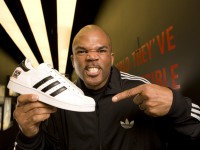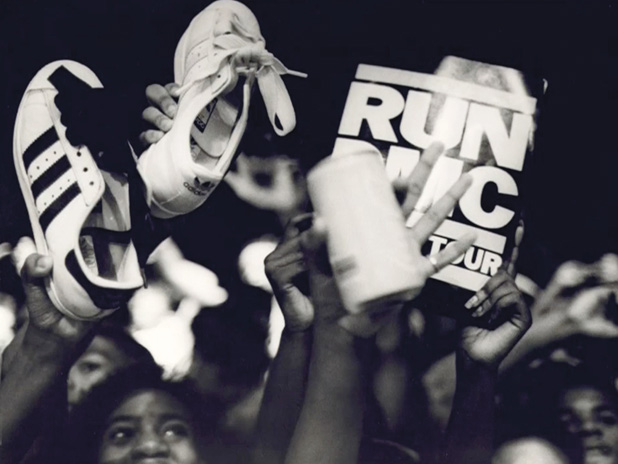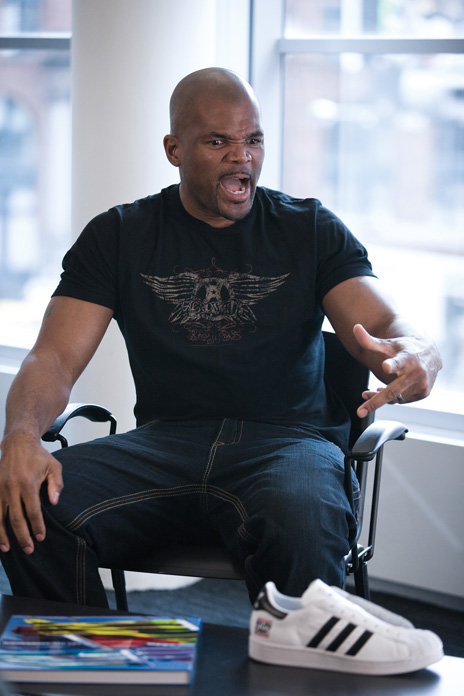 Darryl McDaniels was a member of the famous Hip-Hop band Run DMC and therefore is considered to be one of the Hip Hop pioneers. The adidas tracksuit and shell toe Superstars (always laceless) became part of the band’s image. It was them who made a significant contribution in bringing sneakers and sportswear from the courts to the streets. Run DMC even wrote a song called “My adidas”.
Darryl McDaniels was a member of the famous Hip-Hop band Run DMC and therefore is considered to be one of the Hip Hop pioneers. The adidas tracksuit and shell toe Superstars (always laceless) became part of the band’s image. It was them who made a significant contribution in bringing sneakers and sportswear from the courts to the streets. Run DMC even wrote a song called “My adidas”.
We recently celebrated the 25th anniversary of this song. On this occasion we would like to share an interview with you which we conducted with Darryl three years ago for our adidas brand book (for employees only). Since then the interview hasn’t been publicly distributed. However, we now got the approval to share the interview with the public, too. So read on and get some exclusive insights. The interview took place in New York…the city where everything started.

Darryl, jazz had its Louis Armstrong, rhythm and blues had Ray Charles, rock ’n’ roll had Elvis – and rap had Run DMC. Is that a fair comparison?
Yes, I guess so! A lot of people think that hip-hop and rap started with Run DMC, but there were rappers before us, but what we did, as we said on our record My adidas, was we took the beat from the street and we put it on TV. The perception was that you had to be black to be hip-hop. We made it so that you could live in Beverly Hills, you could live in the ghetto, you could be black, you could be white, it didn’t matter who you were to be hip-hop.
Rap came out of disco, disco was really popular with the DJ but disco was Saturday Night Fever and John Travolta, it was Rolls-Royces, furs, sex and drugs. We looked at that and said that’s not the way the world really is. So we took those disco records, and whenever there was a break in the record, people would sing happy stuff. We put social commentary in there. But as it evolved, we started rapping over jazz records, and James Brown records and funk records, and eventually we started rapping over the rock beat.
Looking at the lyrics of your song “my adidas”, it’s a song that seems to say pretty well everything you want to say, what you do, your career, your philosophy, your aspirations…
 Yeah, actually it was Run’s brother, Russell Simmons, who was our manager at the time, he came to us one night where we used to hang out on the corner of Two Fifth Street, Hollis Avenue in Queens where we grew up. The whole Run DMC thing was taking off. And Russell came up to us and said, you gotta make a record about your sneakers, it should go, like, “My adidas, Standin’ on Two Fifth Street…” He kept singing it and we was saying, yeah, yeah, whatever, whatever.
Yeah, actually it was Run’s brother, Russell Simmons, who was our manager at the time, he came to us one night where we used to hang out on the corner of Two Fifth Street, Hollis Avenue in Queens where we grew up. The whole Run DMC thing was taking off. And Russell came up to us and said, you gotta make a record about your sneakers, it should go, like, “My adidas, Standin’ on Two Fifth Street…” He kept singing it and we was saying, yeah, yeah, whatever, whatever.
But the real evolution of the song came about like this: there was this doctor in our neighbourhood called Doctor Dees, he was affluent and inspirational to the kids, he was a good symbol of what hard work gets you. Every week he would put out a pamphlet dealing with social issues of our neighbourhood: drug dealers, teenage pregnancy, poverty, you know, put your garbage out, stuff like that. One week he wrote this thing called Felon Shoes.
And he wrote if you see the young people of this neighbourhood on the corner with adidas, adidas suits, or jeans, the Kangol hats and the Gazelle glasses, gold chains… if you see a fresh young guy on a corner, decked out in his adidas, that’s the problem with our community. But Doctor Dees was wrong to say that. You can’t judge a book by its cover, because I would say only 30 per cent of that was true. The other 70 per cent was…
I was a straight-A student in Catholic school.
I didn’t sell drugs – I saved my allowance to go buy my adidas. I worked to be able to go buy my fresh adidas. So we said we could use our rap music because it wasn’t just about how good we were and how many sneakers we had, now we had a purpose to make a song about our shoes. We was touring the world at that time, we had Cadillacs and gold chains, so this was our chance to tell not just Doctor Dees but the whole establishment that thought of us like that. That’s why we wrote,
My adidas,
standing on Two Fifth Street,
funky fresh and yes cold on my feet,
with no shoe-string in ’em,
I did not win ’em,
I bought ’em off the Ave …
– bought them! We talked about, don’t you know these young men here, 18, 19, 20 years old, these adidas didn’t just stand on the corner, we was on the stage at Live Aid! And by us being there in our adidas, money was made and it fed the poor. If you listen to the words of My adidas, like you said, we put everything in there, our philosophy, because now the sneaker could represent something good, because the majority of the perception was, oh, you see those sneaker kids, they’re drug dealers. Now that could be true, but not all of us. So the adidas record idea actually gave us a purpose.
Continue Reading at Blog.Adidas-Group.com